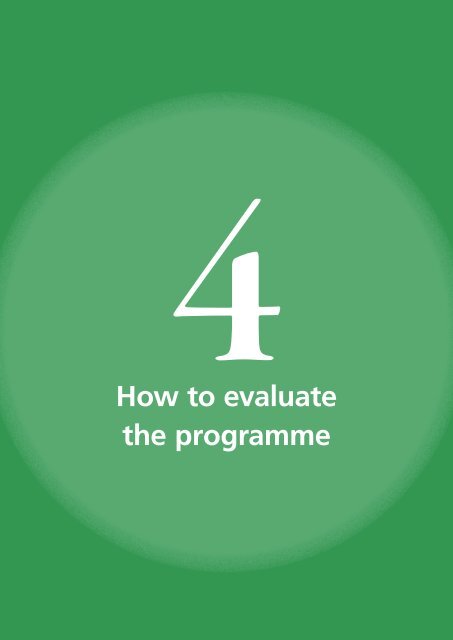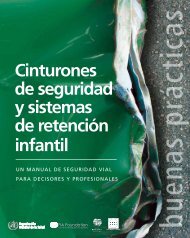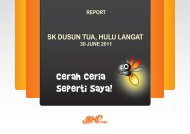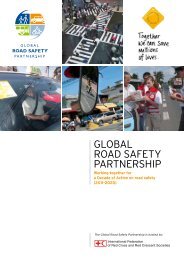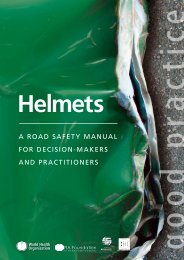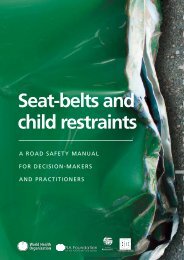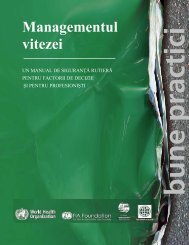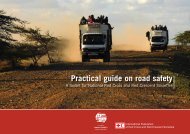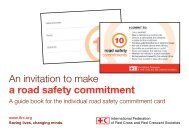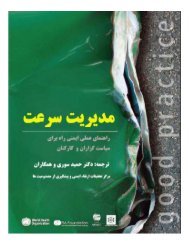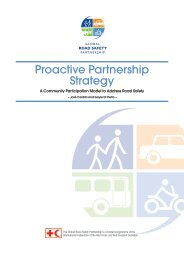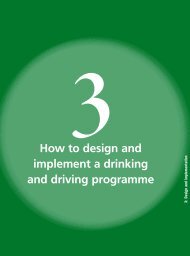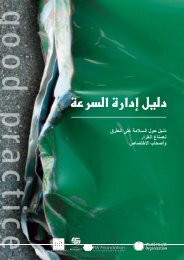How to evaluate the programme - World Health Organization
How to evaluate the programme - World Health Organization
How to evaluate the programme - World Health Organization
You also want an ePaper? Increase the reach of your titles
YUMPU automatically turns print PDFs into web optimized ePapers that Google loves.
4<br />
<strong>How</strong> <strong>to</strong> <strong>evaluate</strong><br />
<strong>the</strong> <strong>programme</strong>
4<br />
<strong>How</strong> <strong>to</strong> <strong>evaluate</strong> <strong>the</strong> <strong>programme</strong><br />
4.1 Planning <strong>the</strong> evaluation.. . . . . . . . . . . . . . . . . . . . . . . 125<br />
4.1.1 Aims of evaluation.. . . . . . . . . . . . . . . . . . . . . . . . . . . . 126<br />
4.1.2 Types of evaluation.. . . . . . . . . . . . . . . . . . . . . . . . . . . . 126<br />
4.2 Choosing <strong>the</strong> evaluation methods. . . . . . . . . . . . . . 127<br />
4.2.1 Study types for formative and process evaluations.. . . . 128<br />
4.2.2 Study types for impact and outcome evaluations.. . . . . 128<br />
4.2.3 Choosing <strong>the</strong> performance indica<strong>to</strong>rs .. . . . . . . . . . . . . 132<br />
4.2.4 Conducting an economic evaluation of a <strong>programme</strong>. . 133<br />
4.2.5 Determining sample size .. . . . . . . . . . . . . . . . . . . . . . . 135<br />
4.3 Dissemination and feedback. . . . . . . . . . . . . . . . . . . 136<br />
Summary.. . . . . . . . . . . . . . . . . . . . . . . . . . . . . . . . . . . . . . . . 138<br />
References .. . . . . . . . . . . . . . . . . . . . . . . . . . . . . . . . . . . . . . 138
Helmets: a road safety manual<br />
Moni<strong>to</strong>ring and evaluation of any <strong>programme</strong> or intervention is vital<br />
<strong>to</strong> determine whe<strong>the</strong>r it works, <strong>to</strong> help refine <strong>programme</strong> delivery, and <strong>to</strong><br />
provide evidence for continuing support of <strong>the</strong> <strong>programme</strong>. Evaluation will not only<br />
provide feedback on <strong>the</strong> effectiveness of a <strong>programme</strong> but will also help <strong>to</strong> determine<br />
whe<strong>the</strong>r <strong>the</strong> <strong>programme</strong> is appropriate for <strong>the</strong> target population, whe<strong>the</strong>r <strong>the</strong>re are<br />
any problems with its implementation and support, and whe<strong>the</strong>r <strong>the</strong>re are any ongoing<br />
concerns that need <strong>to</strong> be resolved as <strong>the</strong> <strong>programme</strong> is implemented.<br />
This module describes <strong>the</strong> process of developing and conducting an evaluation of a<br />
helmet <strong>programme</strong>. It is divided in<strong>to</strong> three key sections:<br />
• 4.1 Planning <strong>the</strong> evaluation: This important initial stage involves collecting data,<br />
in a baseline study, <strong>to</strong> assess <strong>the</strong> situation before going on <strong>to</strong> develop <strong>the</strong> <strong>programme</strong>.<br />
Based on <strong>the</strong> information collected, it is <strong>the</strong>n necessary <strong>to</strong> define <strong>the</strong> aims<br />
of an evaluation, and <strong>to</strong> consider <strong>the</strong> different types of evaluation methods that<br />
could be used for your evaluation.<br />
• 4.2 Choosing <strong>the</strong> evaluation methods: Once <strong>the</strong> type of evaluation has been<br />
determined, <strong>the</strong>re are different methods that can be applied <strong>to</strong> carry out an<br />
evaluation. This section describes <strong>the</strong> different study types possible, explaining<br />
<strong>the</strong> advantages and disadvantages of each type of method. It outlines <strong>the</strong> types of<br />
performance indica<strong>to</strong>rs that can be used <strong>to</strong> measure <strong>the</strong> success of a <strong>programme</strong>.<br />
This section also briefly describes how <strong>to</strong> conduct an economic evaluation, and<br />
provides guidance on calculating sample size.<br />
• 4.3 Dissemination and feedback: This section describes how <strong>to</strong> feed <strong>the</strong> result of<br />
an evaluation back in<strong>to</strong> <strong>the</strong> planning and implementation stages, as well as ways<br />
that <strong>the</strong> results of an evaluation can be shared with different interested parties.<br />
4 | <strong>How</strong> <strong>to</strong> <strong>evaluate</strong> <strong>the</strong> <strong>programme</strong><br />
4.1 Planning <strong>the</strong> evaluation<br />
The process of designing and implementing a helmet <strong>programme</strong> was covered in<br />
Module 3. Work carried out prior <strong>to</strong> implementation should ensure that <strong>the</strong> <strong>programme</strong><br />
is clearly defined and that it is implemented in a consistent and standardized<br />
way. It is far easier <strong>to</strong> <strong>evaluate</strong> <strong>the</strong> impact of a complete, well-planned and executed<br />
<strong>programme</strong> than one that is implemented in an inconsistent way.<br />
It is essential that <strong>the</strong> evaluation framework is developed and implemented alongside<br />
<strong>the</strong> proposed <strong>programme</strong>. Thus, this work would be carried out by <strong>the</strong> working<br />
group as <strong>the</strong>y develop <strong>the</strong> action plan for <strong>the</strong> <strong>programme</strong> (see Module 3). Baseline<br />
measures need <strong>to</strong> be collected before <strong>the</strong> intervention is put in place so that change in<br />
such measures over time may be gauged.<br />
125
Module 4: <strong>How</strong> <strong>to</strong> <strong>evaluate</strong> <strong>the</strong> <strong>programme</strong><br />
The type of evaluation <strong>to</strong> be conducted will depend on a number of fac<strong>to</strong>rs. These<br />
include <strong>the</strong> aims of <strong>the</strong> evaluation itself, as well as <strong>the</strong> objectives of <strong>the</strong> <strong>programme</strong><br />
being <strong>evaluate</strong>d. The type of methodology chosen may also depend on resource<br />
constraints.<br />
4.1.1 Aims of evaluation<br />
Determining <strong>the</strong> aims of <strong>the</strong> evaluation will help <strong>to</strong> determine how best <strong>to</strong> carry<br />
out <strong>the</strong> evaluation. The evaluation may have one or more aims. For example, an<br />
evaluation of helmet legislation and increased enforcement <strong>programme</strong> may<br />
primarily be aimed at determining whe<strong>the</strong>r helmet-wearing rates have gone up<br />
as a result of <strong>the</strong> <strong>programme</strong>. <strong>How</strong>ever, secondary aims may include determining<br />
whe<strong>the</strong>r <strong>the</strong> enforcement has increased, whe<strong>the</strong>r training of police is effective, and<br />
whe<strong>the</strong>r <strong>the</strong> <strong>programme</strong> is acceptable <strong>to</strong> <strong>the</strong> stakeholders. The evaluation in this case<br />
needs <strong>to</strong> be multifaceted.<br />
The breadth of an evaluation will always be limited by <strong>the</strong> resources available and a<br />
well designed simple evaluation can be as powerful as a more complex one.<br />
4.1.2 Types of evaluation<br />
Evaluation may take several forms, and one or more may be appropriate, depending<br />
on <strong>the</strong> aims of <strong>the</strong> specific <strong>programme</strong> <strong>to</strong> be <strong>evaluate</strong>d.<br />
Process evaluation<br />
Ra<strong>the</strong>r than measuring change in outcomes this aspect of evaluation examines<br />
whe<strong>the</strong>r <strong>the</strong> <strong>programme</strong> was carried out as planned. This involves creating a list of<br />
indica<strong>to</strong>rs that need <strong>to</strong> be measured, depending on <strong>the</strong> aims of <strong>the</strong> <strong>programme</strong>. The<br />
results will help <strong>to</strong> identify <strong>the</strong> strengths and weaknesses of <strong>the</strong> <strong>programme</strong>, and<br />
where improvements may be made.<br />
For example, in a media campaign designed <strong>to</strong> increase voluntary use of helmets, a<br />
process evaluation may ask <strong>the</strong>se sorts of questions:<br />
•<br />
•<br />
•<br />
•<br />
•<br />
•<br />
Have <strong>the</strong> campaign products (posters, billboard, radio and television spots) been<br />
pre-tested<br />
<strong>How</strong> often were <strong>the</strong> campaign advertisements run<br />
<strong>How</strong> many people saw <strong>the</strong>m<br />
Was <strong>the</strong> target group being reached<br />
Are high-quality helmets available and affordable in local shops<br />
If <strong>the</strong> intervention involves enforcement of helmet legislation:<br />
▷<br />
▷<br />
▷<br />
Is <strong>the</strong>re noticeable enforcement by police<br />
Are <strong>the</strong> police supportive of <strong>the</strong> campaign<br />
Is <strong>the</strong> penalty sufficient <strong>to</strong> change behaviour<br />
126
Helmets: a road safety manual<br />
▷ Are people able <strong>to</strong> circumvent <strong>the</strong> process (for example, using bribery)<br />
Process evaluations are what are known as “formative”. That is, <strong>the</strong> enquiries carried<br />
out are designed <strong>to</strong> provide information <strong>to</strong> guide <strong>programme</strong> improvement (1).<br />
For example, it may be considered important <strong>to</strong> determine whe<strong>the</strong>r <strong>the</strong> TV adverts<br />
shown as part of a helmet <strong>programme</strong> are appropriate – do <strong>the</strong>y adequately address<br />
<strong>the</strong> issue, are <strong>the</strong> helmets advertised actually available for purchase in <strong>the</strong> region<br />
where <strong>the</strong> adverts will be seen<br />
4 | <strong>How</strong> <strong>to</strong> <strong>evaluate</strong> <strong>the</strong> <strong>programme</strong><br />
Impact assessment<br />
This will determine whe<strong>the</strong>r <strong>the</strong> advertisements have brought about a change. The<br />
impact, or <strong>programme</strong> effect, refers <strong>to</strong> a change in <strong>the</strong> target population that has been<br />
brought about by <strong>the</strong> <strong>programme</strong> – that is, a change that would not have occurred<br />
if <strong>the</strong> <strong>programme</strong> had not happened (1). For example, if <strong>the</strong> helmet <strong>programme</strong><br />
involved airing television advertisements on helmet use, <strong>the</strong> impact assessment might<br />
examine whe<strong>the</strong>r people who had seen <strong>the</strong> advertisements believe that <strong>the</strong>re is a good<br />
chance that <strong>the</strong>y will be fined by <strong>the</strong> police if <strong>the</strong>y do not wear a helmet. Unlike a<br />
process evaluation, this would tend <strong>to</strong> take place at <strong>the</strong> end of a <strong>programme</strong>, as <strong>the</strong><br />
focus would be on <strong>the</strong> outcome.<br />
Outcome evaluation<br />
This is where <strong>the</strong> outcomes are measured <strong>to</strong> see if <strong>the</strong> <strong>programme</strong> was successful. Are<br />
more people now wearing helmets than before Have head injuries been reduced<br />
Are more children wearing helmets <strong>to</strong> school Measuring a change in outcomes<br />
is probably <strong>the</strong> most common form of evaluation as it provides information as <strong>to</strong><br />
whe<strong>the</strong>r <strong>the</strong> <strong>programme</strong> or intervention has actually made a difference.<br />
4.2 Choosing <strong>the</strong> evaluation methods<br />
The methods used for each type of evaluation will vary. Both qualitative and<br />
quantitative methods can be used within <strong>the</strong> design of an evaluation. Qualitative<br />
methods may be employed for <strong>the</strong> formative, and process evaluations, e.g. focus<br />
groups, short-answer or open-ended questionnaires.<br />
Impact and outcome evaluations may be carried out using a variety of quantitative<br />
methods. Using an experimental or quasi-experimental design <strong>to</strong> demonstrate a<br />
change (or not) is <strong>the</strong> most powerful <strong>programme</strong> evaluation for detecting changes in<br />
outcome. The type of methods used will depend on <strong>the</strong> aim and <strong>the</strong> budget for <strong>the</strong><br />
evaluation.<br />
127
Module 4: <strong>How</strong> <strong>to</strong> <strong>evaluate</strong> <strong>the</strong> <strong>programme</strong><br />
4.2.1 Study types for formative and process evaluations<br />
Qualitative studies<br />
Qualitative research tends <strong>to</strong> involve detailed, verbal descriptions of characteristics,<br />
cases, and settings <strong>to</strong> explain reasons underlying various behavioural patterns. Specific<br />
techniques include using focus groups, in-depth interviews, or surveys with short<br />
answers or open-ended questions (2, 3). For example, a question in a formative evaluation<br />
of a media campaign aimed at increasing helmet use may be whe<strong>the</strong>r <strong>the</strong> television<br />
advertisements address <strong>the</strong> question. Focus groups may be set up <strong>to</strong> determine<br />
whe<strong>the</strong>r <strong>the</strong> audience believes that <strong>the</strong> message from <strong>the</strong> television advertisements is<br />
appropriate. Feedback will fur<strong>the</strong>r enhance <strong>the</strong> development of <strong>the</strong> advertisement.<br />
Researchers in Ghana <strong>evaluate</strong>d <strong>the</strong> effectiveness of televised road safety<br />
messages on speeding and alcohol impaired driving (4). Focus groups<br />
were conducted with 50 commercial drivers and addressed coverage, clarity and<br />
appropriateness of messages, including suggestions for improvements. The<br />
advertisements reached, and were unders<strong>to</strong>od by most of <strong>the</strong> target audience,<br />
although some participants were unclear on <strong>the</strong> behaviour that <strong>the</strong> advertisements<br />
were telling viewers <strong>to</strong> take. Opportunities for streng<strong>the</strong>ning <strong>the</strong> messages<br />
included using o<strong>the</strong>r media, increasing <strong>the</strong> number of languages, and stressing<br />
<strong>the</strong> change in behaviour being recommended.<br />
4.2.2 Study types for impact and outcome evaluations<br />
There is a well defined hierarchy of study designs for examining <strong>the</strong> effectiveness of<br />
interventions. These range from randomised control trials, which provide a high level<br />
of evidence, <strong>to</strong> uncontrolled before–after studies which provide very weak evidence<br />
about <strong>the</strong> effectiveness of an intervention.<br />
Randomised control trial (RCT)<br />
The gold standard of evaluation, <strong>the</strong> randomised control trial will provide <strong>the</strong><br />
highest quality level of evidence that an intervention or <strong>programme</strong> is successful.<br />
A RCT design means that individuals or groups of individuals (e.g. a school, or<br />
village, known as a cluster randomised trial) are randomly allocated <strong>to</strong> ei<strong>the</strong>r<br />
receive, or not receive, <strong>the</strong> <strong>programme</strong>. As participants (or groups of participants)<br />
are randomly assigned <strong>to</strong> one group or ano<strong>the</strong>r, o<strong>the</strong>r fac<strong>to</strong>rs that may influence <strong>the</strong><br />
outcome – measured and unmeasured – are more likely <strong>to</strong> be balanced between <strong>the</strong><br />
intervention and non-intervention group. <strong>How</strong>ever, although RCT designs should<br />
always be considered when evaluating effectiveness of an intervention, <strong>the</strong>y do<br />
128
Helmets: a road safety manual<br />
require significant resources and may be difficult <strong>to</strong> conduct with a limited budget.<br />
There may also be ethical considerations in randomising an intervention with known<br />
benefits (that is, in denying an effective intervention <strong>to</strong> those participants who will<br />
be in <strong>the</strong> non-intervention group).<br />
It is important <strong>to</strong> note that <strong>the</strong>re is no need <strong>to</strong> conduct a randomised controlled trial<br />
on <strong>the</strong> effectiveness of helmets <strong>the</strong>mselves as part of your helmet <strong>programme</strong>. There<br />
is sufficient evidence from a number of studies that clearly demonstrate that helmets<br />
are effective at reducing <strong>the</strong> head injuries and fatalities that result during mo<strong>to</strong>rcycle<br />
crashes (see Module 1).<br />
4 | <strong>How</strong> <strong>to</strong> <strong>evaluate</strong> <strong>the</strong> <strong>programme</strong><br />
Evaluation using a randomised controlled trial<br />
A randomized control trial was conducted in 27 schools in Western Australia <strong>to</strong><br />
assess <strong>the</strong> effectiveness of a whole-school intervention <strong>to</strong> increase <strong>the</strong> correct<br />
wearing of bicycle helmets by primary school children (5). Schools were randomly<br />
allocated <strong>to</strong> ei<strong>the</strong>r intervention or control conditions; <strong>the</strong> main component of<br />
<strong>the</strong> <strong>programme</strong> was peer-led classroom curriculum for 10–12 year old children.<br />
Helmet use was observed at baseline, and at one and two years following <strong>the</strong><br />
intervention. Observed wearing rates declined by 13% in <strong>the</strong> control group<br />
compared <strong>to</strong> 5% in <strong>the</strong> intervention group (p=0.185), suggesting that while<br />
school-based activities may not increase helmet use, <strong>the</strong>y may arrest <strong>the</strong> rate<br />
of decline in helmet use in children.<br />
Quasi experimental designs<br />
These study designs, while not as rigorous as randomised trials, if well conducted,<br />
may also be used <strong>to</strong> establish <strong>the</strong> effectiveness of an intervention. That is, using <strong>the</strong><br />
information collected on trends of <strong>the</strong> indica<strong>to</strong>rs measured, <strong>the</strong>se studies allow<br />
conclusions <strong>to</strong> be drawn as <strong>to</strong> whe<strong>the</strong>r or not <strong>the</strong> intervention (<strong>the</strong> <strong>programme</strong>) is<br />
associated with change in <strong>the</strong> outcome.<br />
Controlled before-after study<br />
This is often <strong>the</strong> most practical design for <strong>programme</strong> evaluation. Randomisation<br />
is not always feasible, for example where some areas have already adopted an<br />
intervention. The controlled before–after study design involves observing <strong>the</strong><br />
outcome of interest (e.g. helmet-wearing rates) before and after <strong>the</strong> <strong>programme</strong><br />
in both <strong>the</strong> people who receive <strong>the</strong> <strong>programme</strong>, and those in a control group. The<br />
control group should be as similar as possible <strong>to</strong> <strong>the</strong> <strong>programme</strong> group and any<br />
important differences between <strong>the</strong> groups need <strong>to</strong> be take in<strong>to</strong> account. Having a<br />
129
Module 4: <strong>How</strong> <strong>to</strong> <strong>evaluate</strong> <strong>the</strong> <strong>programme</strong><br />
control group means that trends that may have been occurring in <strong>the</strong> population<br />
aside from what was happening due <strong>to</strong> <strong>the</strong> <strong>programme</strong> are taken in<strong>to</strong> account.<br />
Evaluation using a controlled before-after study<br />
A controlled before-and-after study was used <strong>to</strong> <strong>evaluate</strong> a subsidy <strong>programme</strong><br />
<strong>to</strong> increase bicycle helmet use by children of low-income families (6). The population<br />
included were bicycling children 5 <strong>to</strong> 14 years of age from areas of low<br />
average family income in a defined geographic community within a large urban<br />
Canadian city. Students in three schools located in <strong>the</strong> area of lowest average<br />
family income were offered helmets at $10 each, and were provided with an<br />
educational <strong>programme</strong>; three o<strong>the</strong>r low-income areas served as control areas.<br />
Helmet use was measured by direct observation of more than 1800 bicycling children.<br />
Results from <strong>the</strong> study showed that although 910 helmets were sold <strong>to</strong> a<br />
school population of 1415 (64%), and reported helmet ownership increased from<br />
10% <strong>to</strong> 47%, observed helmet use in <strong>the</strong> low-income intervention area was no<br />
different from <strong>the</strong> rate in <strong>the</strong> three low-income control areas (18% versus 19%).<br />
The authors concluded that <strong>the</strong> results do not support <strong>the</strong> efficacy of a helmet<br />
subsidy <strong>programme</strong> in increasing helmet use in children residing in areas of low<br />
average family income and that developing o<strong>the</strong>r strategies <strong>to</strong> increase helmet<br />
use in children of low average family income should be a priority.<br />
Interrupted time series design<br />
It is possible <strong>to</strong> assess <strong>the</strong> effect of a <strong>programme</strong> by using multiple measures of <strong>the</strong><br />
outcome of interest before and after <strong>the</strong> <strong>programme</strong>. There are a number of different<br />
variations on this design, some involving control groups. Studies that have used <strong>the</strong>se<br />
designs generally use routinely collected measures such as death rates, as multiple<br />
measures are required for appropriate analysis. This study design is, however, subject<br />
<strong>to</strong> time related challenges <strong>to</strong> its validity: <strong>the</strong> possibility that o<strong>the</strong>r fac<strong>to</strong>rs occurring<br />
simultaneously <strong>to</strong> <strong>the</strong> <strong>programme</strong> actually led <strong>to</strong> <strong>the</strong> observed effect. <strong>How</strong>ever, statistical<br />
analysis of such data can take in<strong>to</strong> account any such secular trends, meaning that<br />
it is possible <strong>to</strong> establish whe<strong>the</strong>r <strong>the</strong> intervention or <strong>programme</strong> was responsible for<br />
<strong>the</strong> change in outcome.<br />
Before–after study (no control group)<br />
The before–after study without a control group is often used <strong>to</strong> <strong>evaluate</strong> <strong>the</strong><br />
impact of a <strong>programme</strong>, but provides <strong>the</strong> weakest evidence for <strong>the</strong> effectiveness<br />
of a <strong>programme</strong>. This design involves measuring <strong>the</strong> outcome of interest before<br />
and after <strong>the</strong> <strong>programme</strong> has been run. This study design is simple, and may be<br />
130
Helmets: a road safety manual<br />
conducted relatively cheaply as all that is needed is a sampling frame and research<br />
assistants <strong>to</strong> conduct observations at various sites. <strong>How</strong>ever, without a control group,<br />
<strong>the</strong> scientific merit of <strong>the</strong>se study types is relatively limited as it is often difficult<br />
<strong>to</strong> attribute with any certainty <strong>the</strong> change in outcome <strong>to</strong> <strong>the</strong> introduction of <strong>the</strong><br />
<strong>programme</strong>.<br />
4 | <strong>How</strong> <strong>to</strong> <strong>evaluate</strong> <strong>the</strong> <strong>programme</strong><br />
Evaluating a poster and TV helmet campaign in Cambodia<br />
In 2004 Handicap International launched a<br />
series of helmet-use awareness campaigns, in<br />
collaboration with <strong>the</strong> Cambodian Ministry of<br />
<strong>Health</strong>, <strong>the</strong> <strong>World</strong> <strong>Health</strong> <strong>Organization</strong>, UNICEF,<br />
UNESCO and <strong>the</strong> Belgian Cooperation. The main<br />
campaign featured international film star Jackie<br />
Chan. The campaign targeted young people,<br />
who represent 50% of road traffic casualties in<br />
<strong>the</strong> country’s capital, Phnom Penh, and used<br />
television spots and posters <strong>to</strong> illustrate Chan’s<br />
use of a mo<strong>to</strong>rcycle helmet. Several helmetwearing<br />
surveys conducted before and after <strong>the</strong><br />
campaign allowed <strong>the</strong> organisers <strong>to</strong> <strong>evaluate</strong><br />
<strong>the</strong> campaign’s success. Prior <strong>to</strong> <strong>the</strong> campaign,<br />
<strong>the</strong> average helmet wearing rate, assessed at<br />
20 locations over a 4-day period in <strong>the</strong> city, was 8%. Following <strong>the</strong> campaign’s<br />
implementation, a year and a half later, this level had risen <strong>to</strong> 14.7%.<br />
Source: 7<br />
Jackie Chan, goodwill ambassador for<br />
UNICEF, promotes helmet use in Cambodia.<br />
© Handicap International Belgium and UNICEF 2004<br />
131
Module 4: <strong>How</strong> <strong>to</strong> <strong>evaluate</strong> <strong>the</strong> <strong>programme</strong><br />
Table 4.1 Study types and <strong>the</strong>ir advantages and disadvantages *<br />
Formative<br />
and process<br />
evaluation<br />
Impact and<br />
outcome<br />
evaluation<br />
Pros and cons<br />
QUALITATIVE<br />
Focus groups/in-depth<br />
interviews<br />
✓ – formative<br />
– process<br />
✓ – outcome<br />
– Can provide information on why<br />
intervention may or may not<br />
have worked<br />
– Cheap<br />
– Sample (participants) are not<br />
random sample<br />
– Results are not generalisable<br />
QUANTITATIVE<br />
Randomised controlled trials ✓ – impact<br />
✓ – outcome<br />
Controlled before–after study ✓ – impact<br />
✓ – outcome<br />
– Most rigorous evidence<br />
– Expensive<br />
– Randomisation not always<br />
feasible<br />
– Most practical design<br />
– Must have comparable control<br />
group<br />
Interrupted time series<br />
design<br />
Before–after study (no<br />
control group)<br />
✓ – impact<br />
✓ – outcome<br />
✓ – impact<br />
✓ – outcome<br />
– Practical design if sufficient<br />
numbers of events and accurate<br />
surveillance systems in place<br />
– Cheap<br />
– Low level of evidence<br />
* Fur<strong>the</strong>r detail about study types is available in references 8 and 9. There is also a useful online glossary of epidemiological terms<br />
at www.cochrane.org/resources/glossary.htm<br />
4.2.3 Choosing <strong>the</strong> performance indica<strong>to</strong>rs<br />
Performance indica<strong>to</strong>rs (or outcome measures) are a measure of how successful<br />
<strong>the</strong> <strong>programme</strong> has been. Choice of performance indica<strong>to</strong>rs will be determined<br />
by <strong>the</strong> aims of <strong>the</strong> evaluation, <strong>the</strong> study type used, <strong>the</strong> resources available and, <strong>to</strong> a<br />
certain extent, <strong>the</strong> requirements of <strong>the</strong> funding agency. For instance, government<br />
funding agencies may require certain information <strong>to</strong> ensure support for increased<br />
enforcement or for fur<strong>the</strong>r roll-out of a <strong>programme</strong>.<br />
Injury and death outcomes<br />
The effectiveness of both mo<strong>to</strong>rcycle and bicycle helmets in reducing crash-related<br />
head injury and death has been well documented in many studies including two<br />
Cochrane systematic reviews (see Module 1) (10,11) and <strong>the</strong>re may be no need <strong>to</strong><br />
replicate <strong>the</strong>se findings in a large scale (and possibly expensive) piece of experimental<br />
research. <strong>How</strong>ever, much of this effectiveness research has been conducted in<br />
high-income countries (predominantly <strong>the</strong> USA) where high-quality helmets are<br />
132
Helmets: a road safety manual<br />
common. There is very little published research examining <strong>the</strong> effectiveness of light<br />
weight or locally developed helmets in reducing injury and death in low- and middleincome<br />
countries, particularly with regard <strong>to</strong> mo<strong>to</strong>rcycle helmets. Fur<strong>the</strong>r research in<br />
this area is important as use of such helmets is increasing.<br />
It is possible <strong>to</strong> use routinely collected data <strong>to</strong> calculate head injury and death rates.<br />
<strong>How</strong>ever, <strong>the</strong> efficiency with which such rates can be calculated depends on <strong>the</strong> accuracy<br />
of local surveillance. If <strong>the</strong>re is a uniform capture, coding and reporting system<br />
already set up in hospitals and/or health departments <strong>the</strong>re may be aggregated data<br />
available on head injury, serious head injury or mo<strong>to</strong>rcycle crash-related head injury.<br />
O<strong>the</strong>rwise this may need <strong>to</strong> be abstracted from local data sources. Similarly, mo<strong>to</strong>rcycle<br />
crash and/or death data may be routinely collected from police or transport<br />
authorities.<br />
As quality may be variable, completeness and accuracy of <strong>the</strong>se data sources should<br />
be carefully checked before use.<br />
4 | <strong>How</strong> <strong>to</strong> <strong>evaluate</strong> <strong>the</strong> <strong>programme</strong><br />
Helmet-wearing rates<br />
Ano<strong>the</strong>r appropriate performance indica<strong>to</strong>r is <strong>the</strong> proportion of riders wearing<br />
helmets. Observations of riders may be made at a number of sites before and after a<br />
<strong>programme</strong> <strong>to</strong> document whe<strong>the</strong>r helmet-wearing rates have changed.<br />
Calculating rates<br />
Comparing changes in absolute numbers in injury and death outcomes, or in riders<br />
wearing helmets, before and after a <strong>programme</strong> is not useful, as absolute numbers<br />
may change due <strong>to</strong> an increase or decrease in <strong>the</strong> numbers of riders, registered or o<strong>the</strong>rwise.<br />
It is <strong>the</strong>refore important that rates be calculated. Denomina<strong>to</strong>rs may include<br />
number of riders, registered bikes, or kilometres travelled. For example, for injury<br />
outcomes a rate may be number of injuries per licensed riders, or number of injuries<br />
per 100 000 km ridden. For helmet use, <strong>the</strong> appropriate rate would be <strong>the</strong> proportion<br />
of helmeted riders over <strong>to</strong>tal riders observed. Note that it is preferable <strong>to</strong> use a population<br />
denomina<strong>to</strong>r (e.g. per 100 000 population), ra<strong>the</strong>r than <strong>the</strong> number of mo<strong>to</strong>rcycles<br />
as a denomina<strong>to</strong>r. This is because <strong>the</strong> rapidly increasing use of mo<strong>to</strong>rcycles in<br />
many countries may dis<strong>to</strong>rt <strong>the</strong> results of an evaluation, if this latter measure is used.<br />
Module 2 includes a detailed section on how <strong>to</strong> measure helmet-wearing rates.<br />
4.2.4 Conducting an economic evaluation of a <strong>programme</strong><br />
It may also be necessary <strong>to</strong> conduct an economic evaluation <strong>to</strong> demonstrate ‘value<br />
for money’ and possible cost savings for government by investing in prevention.<br />
Economic evaluation addresses <strong>the</strong> question of whe<strong>the</strong>r one intervention represents a<br />
better use of resources than ano<strong>the</strong>r. In o<strong>the</strong>r words, does spending $x on <strong>programme</strong><br />
A represent a better investment than $y on <strong>programme</strong> B To address this sort of<br />
133
Module 4: <strong>How</strong> <strong>to</strong> <strong>evaluate</strong> <strong>the</strong> <strong>programme</strong><br />
question, it is apparent <strong>the</strong>refore that a comparison of two or more options is needed<br />
(sometimes this comparison is with a ‘do nothing’ or ‘status quo’ alternative).<br />
Economic evaluation is based on <strong>the</strong> comparison of alternatives in terms of <strong>the</strong>ir<br />
costs and consequences (12). The term ‘consequences’ is used here <strong>to</strong> represent<br />
an outcome of value. There are various forms of economic evaluation that can be<br />
conducted – each differing in terms of scope, i.e. <strong>the</strong> range of variables included in<br />
<strong>the</strong> analysis. Importantly, each form of economic evaluation typically entails a set of<br />
starting assumptions; recognition of <strong>the</strong>se is necessary for <strong>the</strong> policy-maker <strong>to</strong> make<br />
appropriate use of <strong>the</strong> evidence from such studies.<br />
A common element across all forms of economic evaluation is that <strong>the</strong>y involve<br />
measuring costs. Costs usually comprise, at least in part, <strong>the</strong> direct <strong>programme</strong> costs<br />
– <strong>the</strong> resources that are used <strong>to</strong> run <strong>the</strong> <strong>programme</strong> (e.g. equipment, staff, consumables).<br />
<strong>How</strong>ever, in principle, o<strong>the</strong>r costs may also be relevant such as those incurred<br />
by patients, carers and <strong>the</strong> wider community. Fur<strong>the</strong>rmore, <strong>the</strong>re are ‘downstream’<br />
costs and cost savings that may enter in<strong>to</strong> consideration e.g. a <strong>programme</strong> may result<br />
in reduced hospitalisations and <strong>the</strong>se savings in resources may be deemed relevant.<br />
The type of costs selected generally depends on <strong>the</strong> perspective taken in <strong>the</strong> evaluation<br />
and <strong>the</strong> nature of <strong>the</strong> resource allocation problem being addressed.<br />
Methods used in economic evaluation<br />
The most common form of economic evaluation is cost effectiveness analysis<br />
(CEA). This entails <strong>the</strong> <strong>to</strong>tal cost of <strong>programme</strong>s alongside a defined outcome <strong>to</strong><br />
produce a ‘cost-effectiveness ratio’ (e.g. cost per life saved, cost per life year saved or<br />
cost per case prevented). The assumption in CEA is that <strong>the</strong> objectives of interventions<br />
being compared are adequately captured in <strong>the</strong> measure of outcome used (13).<br />
One modification <strong>to</strong> conventional cost effectiveness analysis is cost-utility analysis<br />
which is based on an outcome measure, Quality Adjusted Life Year (QALY), that<br />
incorporates change in survival and quality of life and <strong>the</strong>reby enables a wider set of<br />
interventions <strong>to</strong> be legitimately compared than would be possible with CEA.<br />
Ano<strong>the</strong>r form of economic evaluation is cost-benefit analysis (CBA) which seeks<br />
<strong>to</strong> <strong>evaluate</strong> interventions in terms of <strong>to</strong>tal costs and <strong>to</strong>tal benefits – both dimensions<br />
being valued in monetary terms (e.g. dollars). Therefore if benefits are greater than<br />
costs, <strong>the</strong> decision would be <strong>to</strong> fund <strong>the</strong> <strong>programme</strong>. Valuation of health benefits in<br />
this way can be challenging, but one approach would be <strong>to</strong> elicit from beneficiaries<br />
of programs <strong>the</strong>ir maximum willingness <strong>to</strong> pay for <strong>the</strong>se benefits (i.e. if <strong>the</strong>y had <strong>to</strong><br />
pay for it in a hypo<strong>the</strong>tical market place). The idea behind this approach is <strong>to</strong> derive<br />
a valuation for an intervention akin <strong>to</strong> <strong>the</strong> way in which consumers value goods and<br />
services in markets.<br />
Choosing <strong>the</strong> appropriate type of economic analysis for <strong>the</strong> needs of <strong>the</strong> particular<br />
<strong>programme</strong> will depend on resources available (both economic and human resources),<br />
and <strong>the</strong> aims of <strong>the</strong> evaluation. Taking quality of life in<strong>to</strong> account is a powerful<br />
134
Helmets: a road safety manual<br />
measure for evaluations of mo<strong>to</strong>rcycle crashes where lifelong disability resulting from<br />
serious head injury is an outcome.<br />
4.2.5 Determining sample size<br />
For all quantitative study types it is important <strong>to</strong> have sufficiently large numbers in<br />
<strong>the</strong> study <strong>to</strong> be sure that if an effect exists it is detectable. The rarer <strong>the</strong> event, <strong>the</strong><br />
greater <strong>the</strong> sample size needs <strong>to</strong> be in order <strong>to</strong> detect a difference. Serious injuries<br />
from mo<strong>to</strong>rcycle crashes are relatively rare events and a study using serious injury or<br />
death as an outcome would involve a large sample size. Measuring helmet-wearing<br />
rates requires a smaller number of participants.<br />
4 | <strong>How</strong> <strong>to</strong> <strong>evaluate</strong> <strong>the</strong> <strong>programme</strong><br />
Fac<strong>to</strong>rs that must be taken in<strong>to</strong> consideration in determining <strong>the</strong> sample size are <strong>the</strong><br />
expected size of <strong>the</strong> effect <strong>to</strong> be detected, variability in <strong>the</strong> measures, and <strong>the</strong> prevalence<br />
of <strong>the</strong> variable of interest. For a cluster randomised trial, sample size calculations<br />
will also take <strong>the</strong> size of <strong>the</strong> cluster and correlation within clusters in<strong>to</strong> account.<br />
For fur<strong>the</strong>r information on sample size calculations for cluster randomised trials see<br />
reference 14.<br />
Sample size calcula<strong>to</strong>rs are freely available on <strong>the</strong> internet, but it is wise <strong>to</strong> consult a<br />
statistician regarding such estimates, particularly where cluster randomised trials or<br />
random and/or stratified samples are necessary.<br />
Economic evaluation<br />
A study was carried out <strong>to</strong> compare cost effectiveness for three different <strong>programme</strong>s<br />
aimed at increasing bicycle helmet use in children between <strong>the</strong> ages<br />
of 5 and 16 (a legislative <strong>programme</strong>, a community-based <strong>programme</strong> and a<br />
school-based <strong>programme</strong>). Over a four-year period, it <strong>to</strong>ok account of <strong>the</strong> direct<br />
costs of <strong>the</strong> <strong>programme</strong> (costs of helmets and o<strong>the</strong>r programmatic costs) and<br />
<strong>the</strong> savings in health care expenditures due <strong>to</strong> prevention of bicycle-related head<br />
injury. The outcomes were head injuries prevented, deaths averted and years of<br />
life saved and were modelled on <strong>the</strong> basis of avoided cases, expected cases,<br />
increased risk of bicycle-related head injury from not wearing a bicycle helmet<br />
during a crash, and <strong>the</strong> pre- and post-intervention prevalence of not wearing a<br />
helmet. Overall, <strong>the</strong> legislative <strong>programme</strong> appeared <strong>to</strong> be <strong>the</strong> most cost effective,<br />
followed by <strong>the</strong> community-based <strong>programme</strong> and <strong>the</strong>n <strong>the</strong> school-based<br />
<strong>programme</strong> (15).<br />
Links <strong>to</strong> online sample size calcula<strong>to</strong>rs may be found at http://calcula<strong>to</strong>rs.stat.ucla.edu/sampsize/php or<br />
alternatively <strong>the</strong> statistical package Epi Info may be downloaded at http://www.cdc.gov/epiinfo/<br />
A sample size calcula<strong>to</strong>r for cluster randomised trials may be found at www.abdn.ac.uk/hsru/epp/cluster.shtml<br />
135
Module 4: <strong>How</strong> <strong>to</strong> <strong>evaluate</strong> <strong>the</strong> <strong>programme</strong><br />
Statistical Analysis<br />
For quantitative study designs data will require statistical analysis. For more advice<br />
on how <strong>to</strong> go about this refer <strong>to</strong> reference 8, or see <strong>the</strong> relevant lectures in <strong>the</strong> basic<br />
methods and injury sections at www.pitt.edu/~super1.<br />
4.3 Dissemination and feedback<br />
Once an evaluation is complete it is important <strong>to</strong> provide feedback <strong>to</strong> <strong>the</strong> stakeholders<br />
involved in <strong>the</strong> <strong>programme</strong>. Dissemination of <strong>the</strong> results will help <strong>to</strong> garner<br />
fur<strong>the</strong>r support for <strong>the</strong> <strong>programme</strong> if it is successful, and help o<strong>the</strong>rs gain support<br />
for <strong>the</strong> introduction of similar <strong>programme</strong>s. Publicity from dissemination activities<br />
may also increase <strong>the</strong> impact of <strong>the</strong> <strong>programme</strong>. If <strong>the</strong> <strong>programme</strong> has not been successful<br />
it is important <strong>to</strong> share this with o<strong>the</strong>rs so that weaknesses or relevant issues<br />
are considered in o<strong>the</strong>r similar interventions, including whe<strong>the</strong>r or not <strong>to</strong> introduce<br />
such interventions.<br />
Dissemination may involve presenting <strong>the</strong> results at public meetings, using <strong>the</strong> media<br />
<strong>to</strong> publicise <strong>the</strong> outcomes of <strong>the</strong> <strong>programme</strong>, or publishing reports and papers in <strong>the</strong><br />
scientific literature.<br />
Checklist<br />
Start evaluation process at <strong>the</strong> beginning of <strong>programme</strong> implementation.<br />
Determine aim of evaluation and develop evaluation framework.<br />
Clearly define target population, place and time.<br />
Develop and test instruments for data collection, ensuring consistency in training and<br />
measurement.<br />
Collect and analyse data.<br />
Write and disseminate evaluation report, feeding back in<strong>to</strong> various aspects of <strong>programme</strong>.<br />
Using evaluation results <strong>to</strong> feed back in<strong>to</strong> new planning cycle<br />
Consider whe<strong>the</strong>r <strong>the</strong> evaluation demonstrated any tangible benefits – should <strong>the</strong><br />
<strong>programme</strong> be continued, or does it require disbanding or modification Can <strong>the</strong><br />
existing <strong>programme</strong> be improved on <strong>the</strong> basis of <strong>the</strong> evaluation Have <strong>the</strong>re been any<br />
unexpected side effects of <strong>the</strong> <strong>programme</strong><br />
136
Helmets: a road safety manual<br />
The results of <strong>the</strong> evaluation should be fed back in<strong>to</strong> <strong>the</strong> planning cycle and <strong>the</strong><br />
appropriate modifications <strong>to</strong> <strong>the</strong> <strong>programme</strong> made before it is fur<strong>the</strong>r expanded<br />
(Box 4.1).<br />
BOX 4.1: Increasing bicycle helmet use in schools in Malaysia<br />
4 | <strong>How</strong> <strong>to</strong> <strong>evaluate</strong> <strong>the</strong> <strong>programme</strong><br />
Bicycle fatalities constitute about 4%<br />
of all road traffic fatalities in Malaysia.<br />
The majority of <strong>the</strong>se deaths result from<br />
head injuries and tend <strong>to</strong> occur in rural<br />
areas. Until <strong>the</strong> 1990s, <strong>the</strong> use of bicycle<br />
helmets was rare in Malaysia. The first<br />
bicycle helmet <strong>programme</strong> was launched<br />
in 1995 by <strong>the</strong> Malaysian Helmet Initiative,<br />
a consortium of university, governmental<br />
and nongovernmental organizations that<br />
promotes <strong>the</strong> use of mo<strong>to</strong>rcycle and bicycle<br />
helmets. With support from corporate<br />
funders, <strong>the</strong> <strong>programme</strong> is a model of<br />
how different sec<strong>to</strong>rs can work <strong>to</strong>ge<strong>the</strong>r<br />
<strong>to</strong> prevent head injuries.<br />
The bicycle helmet <strong>programme</strong> was<br />
a multisec<strong>to</strong>ral initiative carried out by<br />
<strong>the</strong> country’s Road Safety Council at<br />
both state and district levels, and targeting<br />
rural children through local schools.<br />
Children who cycled <strong>to</strong> school were trained in <strong>the</strong><br />
proper use of helmets, which were provided free<br />
<strong>to</strong> those in <strong>the</strong> <strong>programme</strong>. With <strong>the</strong>ir parents also<br />
consenting, <strong>the</strong> children promised <strong>to</strong> use <strong>the</strong>ir helmets<br />
at all times when cycling. Their compliance in<br />
helmet use was assessed by <strong>the</strong> students <strong>the</strong>mselves,<br />
through questionnaires on <strong>the</strong> use of <strong>the</strong><br />
helmets, and through <strong>the</strong>ir reports on any crashes<br />
<strong>the</strong>y were involved in while cycling. Compliance was<br />
also confirmed by <strong>the</strong> school authorities and by <strong>the</strong><br />
<strong>programme</strong> organizers, who made unannounced<br />
monthly “spot checks” on children cycling <strong>to</strong> or<br />
from school.<br />
The results showed that compliance among <strong>the</strong><br />
students involved ranged from 31% <strong>to</strong> 98% across<br />
<strong>the</strong> various schools. The commitment of school<br />
authorities <strong>to</strong> <strong>the</strong> <strong>programme</strong> was considered a<br />
vital ingredient for sustaining <strong>the</strong> commitment of <strong>the</strong><br />
children involved. When asked why <strong>the</strong>y didn’t use<br />
helmets, children reported pressure not <strong>to</strong> do so<br />
Students are shown how <strong>to</strong> fit <strong>the</strong>ir bicycle helmets as part of this broad campaign<br />
<strong>to</strong> increase helmet use in Malaysian schools.<br />
from <strong>the</strong>ir peers, a lack of s<strong>to</strong>rage space at school<br />
for <strong>the</strong> helmets, and <strong>the</strong>ir unappealing colour.<br />
The lessons learnt from <strong>the</strong>se early <strong>programme</strong>s<br />
were incorporated in<strong>to</strong> subsequent ones. Children<br />
were charged a small fee for <strong>the</strong>ir helmets (ra<strong>the</strong>r<br />
than receiving <strong>the</strong>m free of charge), <strong>the</strong>re was an<br />
expanded choice of colour and design of <strong>the</strong> helmets,<br />
and suitable s<strong>to</strong>rage places for helmets were<br />
arranged in schools. Community partners have been<br />
brought in<strong>to</strong> <strong>the</strong> <strong>programme</strong>s and strenuous efforts<br />
made <strong>to</strong> ensure that <strong>the</strong> school authorities sustain<br />
<strong>the</strong>ir commitment <strong>to</strong> <strong>the</strong> initiative.<br />
Since <strong>the</strong> initial <strong>programme</strong> was launched in 1995,<br />
many of <strong>the</strong> schools involved have expanded <strong>the</strong>ir<br />
<strong>programme</strong>s, and at least one bicycle helmet <strong>programme</strong><br />
is now running in each state of Malaysia. In<br />
<strong>to</strong>tal, about 4000 students in 50 schools and about<br />
200 teachers have been involved in <strong>the</strong>se efforts<br />
aimed at reducing head injuries among children<br />
using bicycles.<br />
© Malaysian Helmet Initiative 2005<br />
137
Module 4: <strong>How</strong> <strong>to</strong> <strong>evaluate</strong> <strong>the</strong> <strong>programme</strong><br />
Summary<br />
• Evaluation should be seen as an integral component of any helmet <strong>programme</strong>.<br />
An evaluation needs <strong>to</strong> be determined at <strong>the</strong> beginning of a <strong>programme</strong> development,<br />
such that <strong>the</strong> plan for data collection for this purpose is built in<strong>to</strong> project<br />
implementation. As well as providing information on <strong>the</strong> effectiveness of a<br />
<strong>programme</strong>, evaluation will help identify if <strong>the</strong>re are any problems in running a<br />
<strong>programme</strong>.<br />
• Determining <strong>the</strong> aims of <strong>the</strong> evaluation will help <strong>to</strong> decide how best <strong>to</strong> carry out<br />
<strong>the</strong> evaluation. There are a number of different methods that can be used <strong>to</strong> <strong>evaluate</strong><br />
a helmet <strong>programme</strong>. Each method has various advantages and disadvantages,<br />
and <strong>the</strong> choice of which <strong>to</strong> use will depend on <strong>the</strong> aims of <strong>the</strong> helmet <strong>programme</strong>,<br />
and <strong>the</strong> resources available.<br />
• It is important that <strong>the</strong> results of <strong>the</strong> evaluation are shared with <strong>the</strong> appropriate<br />
parties, and that <strong>the</strong>y are used in planning of <strong>the</strong> <strong>programme</strong>.<br />
References<br />
1. Rossi PH et al. Evaluation: a systematic approach. California, Sage Publications, 2004.<br />
2. Britten N. Qualitative research: Qualitative interviews in medical research. British Medical<br />
Journal, 1995, 311:251–253.<br />
3. Kitzinger J. Qualitative research: Introducing focus groups. British Medical Journal, 1995,<br />
311:299–302.<br />
4. Blantari J et al. An evaluation of <strong>the</strong> effectiveness of televised road safety messages in Ghana.<br />
International Journal of Injury Control & Safety Promotion, 2005, 12:23–29.<br />
5. Hall M et al. Evaluation of a school-based peer leader bicycle helmet intervention. Injury Control<br />
and Safety Promotion, 2004, 11:165–174.<br />
6. Parkin PC et al. Evaluation of a subsidy <strong>programme</strong> <strong>to</strong> increase bicycle helmet use by children of<br />
low-income families. Pediatrics, 1995, 96(2 Pt 1):283–287.<br />
7. Jackie Chan promotes helmet use in Cambodia (Press release, Phnom Penh, 25 April 2005).<br />
(www.handicapinternational.be/downloads/Jackie_Chan_promotes_helmet_use.pdf ).<br />
8. Woodward M. Epidemiology: study design and data analysis. 2nd edition. Chapman and Hall<br />
CRC, Boca Ra<strong>to</strong>n, 2005.<br />
9. Rothman, KJ, Greenland S. Modern Epidemiology. 2nd ed. Hagers<strong>to</strong>wn Maryland, Lippincott-<br />
Raven, 1998.<br />
10. Thompson DC, Rivara FP, Thompson R. Helmets for preventing head and facial injuries in<br />
bicyclists. The Cochrane Database of Systematic Reviews, 2005 (4).<br />
11. Liu B et al. Helmets for preventing injury in mo<strong>to</strong>rcycle riders. The Cochrane Database of<br />
Systematic Reviews, 2005 (4).<br />
12. Drummond MF et al. Methods for <strong>the</strong> economic evaluation of health care <strong>programme</strong>s, Oxford,<br />
Oxford University Press, 1997.<br />
138
Helmets: a road safety manual<br />
13. Tan-Torres T et al, eds. WHO guide <strong>to</strong> cost-effectiveness analysis. Geneva, <strong>World</strong> <strong>Health</strong><br />
<strong>Organization</strong>, 2003.<br />
14. Kerry SM, Bland JM. Statistics notes: Sample size in cluster randomisation. British Medical<br />
Journal, 1998, 316:549.<br />
15. Hatziandreu EI et al. The cost effectiveness of three programs <strong>to</strong> increase <strong>the</strong> use of bicycle<br />
helmets among children. Public <strong>Health</strong> Reports, 1995, 110:251–259.<br />
4 | <strong>How</strong> <strong>to</strong> <strong>evaluate</strong> <strong>the</strong> <strong>programme</strong><br />
139
140<br />
Module 4: <strong>How</strong> <strong>to</strong> <strong>evaluate</strong> <strong>the</strong> <strong>programme</strong>


